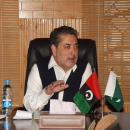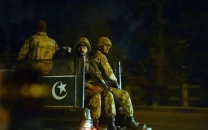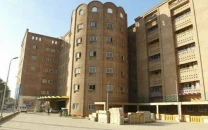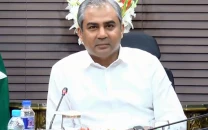Fall sick with the healing: The 'killer' history of Karachi's first flyover
This city’s first flyover was built to save lives — the ones that came after it took them.

This city’s first flyover was built to save lives — the ones that came after it took them. PHOTO: FILE
“It is unique because it was the first time box girder technology was used in Pakistan,” he says from behind his file-bound desk in Umar Munshi Associates in Gulshan (turn left at Mashallah General store and the tyre shop).
The ashtray bristles like a porcupine with the half-smoked stubs of his white Hi Lite cigarettes. As Ejaz Munshi gestures, a silver link bracelet reveals itself below the rolled-up cuff of his blue shirt’s right sleeve.
Ejaz is a man painfully aware of his weighty lineage and the great engineers who were associated with his father whose prowess is manifest in Habib Bank Plaza, Jam Sadiq bridge and many more. Ejaz may be in his 50s now, but he is quite youthful aside from a flutter of grey by his temples and a coin-shaped marking you’ll find on the foreheads of men who pray often. He is still ‘the son’ who lives in his father’s shadow, even though he took over the company three decades ago.
“People have criticism,” he generously admits. They say things like his father was the better engineer, Ejaz wasn’t as strong technically; he is someone more interested in business.

This self-effacement tends to eclipse any acknowledgement of progress he may have made for the company. If Umar Munshi built great things, his son has expanded their work to Afghanistan, Kenya, Bangladesh, Yemen not to mention the many projects in Pakistan. It’s just that in the world of flyovers and bridges, roads and cities, we marvel at their physicality, impressed by their great bigness and the men who dare to build them. The men who admire Umar Munshi are old school — they do not consider business sense a talent.
And so when you ask Ejaz Munshi to tell you about the city’s first flyover, he gestures to engineers Anees Hashim and Khalil Ahmed (now at Loya Associates) who worked with his father, the man who designed it but died before the first swing of the pickaxe.

The construction of the Nazimabad No.2 flyover as reported on August 27, 1991. It took two more years to complete. PHOTO: DAWN
Where it all began
The traffic engineers to trust are the ones with the Abe Lincoln beards with no moustache. Their desks tend to have sharpened Deer pencils, the kinds whose black-tipped ends had a special smell to them. The grey hulking outcome of their labours fools us into thinking they are cold technicians. But when we use the things they build we realise they are sociologists at heart — men who study human behaviour.
There was a time in Karachi when these engineers were emerging in batches of 30 from institutions like NED and Mehran universities. It was a time of slide rules, not calculators. This was still a Karachi whose development authority believed in hiring professionals and not parchis.

In the early 1980s these engineers began to appear in the halls of Civic Centre, that cavernous white labyrinth that houses our city’s managers. One of them, Khalid Masroor, can still be found on the sixth floor in a box-sized office partitioned awkwardly into a waiting area and space for his desk. If you want to know about this city’s flyovers he is generally the best person to ask given that he built 18 of them.
This and other information are stored in his office’s faux ante-chamber that is lined by cheap cupboards, tightly locked and numbered. In his office each day, he comes to work to face a map of Karachi’s roads and flyovers made in 2009. In another room, stuffed black Korona ring binder files bear titles such as ‘Time Medicos’ (the flyover at National Stadium).
Even though he holds the title of senior engineer and has worked in city government for three decades, the lean Masroor looks deceptively un-old. What will perhaps give him away are a head of near-white hair and an elephant’s memory of the city’s flyover projects. Forget the library, there is none. Your best bet is to wheedle your way into his repository of official paperwork. With an irritated snap he’ll summon a clerk and tell him to get “arey wo wallah” file, which the clerk will somehow intuitively understand.
Piecing together the history of the city’s first flyover has been a task mostly reliant on the memory of engineers and bureaucrats. Given the absence of institutional memory there is plenty of margin for error. Even newspaper archives are riddled with inaccuracies. Official files from 30 years ago have been lost.

The TEB’s 1983 report analysing Nazimabad No.2’s accidents
What most of the people linked to this story remember, though, is just how bad it used to be.
Masroor had just started working at Civic Centre in the early 1980s. When the day’s work would wind down, he would make his decision to venture home based on a quick aerial survey. You could do this from the sixth floor where the transport department is now located. You can stand in the catwalk that connects the wings of the building and look down into the Hasan Square intersection. Masroor would often check how bad traffic was. “We couldn’t leave the office,” he says, recalling the frequent gridlocks. “Either you left before 4:30pm or after 7pm.” That formula to avoid rush-hour madness is still applied in the year 2013. Some things never change in Karachi.
And just as the Hassan Square intersection was beginning to clog up, so did Nazimabad No.2. “The trouble had started at Petrol Pump,” says 60-year-old Khalil saheb of Loya Associates. “It would take us 30 to 45 minutes to cross it.”
Gearing up
Given the rumblings of discontent, in 1981 and 1982, the Karachi Development Authority (KDA) opened its Traffic Engineering Bureau (TEB) and within it the Accident Research Unit. One of their tasks was to survey Karachi’s roads to understand why, where and how accidents were taking place. Black spots were those marked by more than five accidents.

The form the traffic engineering bureau used in the 1980s to analyse each accident that took place in Karachi. Such scientific work is not done today. SOURCE: TCD, KMC
The bureau prepared a map to the scale of 1:4,000 or 16 inches for a mile. It was a squared-based grid marked horizontally and vertically as ABC and 123. Every intersection could thus be quickly located by its alphabetic and numeric combination. One intersection could be labeled A020, for example. The passionate pioneers for the traffic engineering bureau even sought help from the UK’s Transport Research Lab to get organised.
On this nine-man Accident Research Unit team was an NED graduate, Muhammad Athar, who had just joined KDA. Today he is a senior director for the Transport & Communication department (TCD), armed with a laser pointer and an ability to walk you through the most technical of projects without skipping a beat. Don’t be impatient and interrupt him with questions on how the traffic engineering bureau worked; all will be revealed as he methodically tells the story in a linear progression that would put differential equations to shame: “We generated macro and micro reports.” Macro for the overall trend in accidents, total numbers (fatal and non-fatal), by vehicle type. Micro meant identifying the black spots. They even enlisted the help of NED students to count vehicles crossing intersections like Nazimabad No. 2. (In fact, Ejaz Munshi was one of them at the time.)

“We were on duty 24 hours,” adds engineer Syed Saeed Akhtar Rizvi, who was also on the team. Today he is a TCD additional district officer. “We’d hear about [an accident] on the wireless.” The police would visit the spot but so did a mobile unit of engineers from the TEB. They took with them a specially designed form for accident analysis.
The Urdu and English form, roughly the size of half a tabloid newspaper, was printed on both sides on thick, creamy paper. It was divided into boxes for every conceivable piece of information related to an accident - from whether the ‘pedestrian’ was sitting or standing to the condition of the tyres to whether the street was lit properly. There was even a space for the engineer to sketch how the accident happened.
Instrumental to this effort was Malik Zaheer ul Islam as the first director of the TEB. “Accidents are indicators of a failure of the transport system,” he explains. “Just like a doctor who gets a blood test [and] urine test, traffic engineers also do a diagnosis [of accidents].”
They didn’t have many resources in those days and Malik Zaheer recalls how he would get on a motorcycle with a colleague, the late Aleem Shujaat Taimoori, and head out into the traffic with his measuring tape.
Malik Zaheer developed 99 of what they called RUM codes for Road User Movement to document each accident. So, for example, number 58 was ‘struck animal’ and showed the picture of a cow. Some of the more cryptically labeled RUM codes were No. 95 ‘Parked Car Ran Away’.
At the end of two years (Jan 1981 to Jan 1983) of painstaking collecting accident data, the TEB could tell by time, distance, vehicle type, day of the week, fatalities the profile of accidents in Karachi. They discovered that Nazimabad No. 2 was a bad spot. The intersection connected Nawab Siddique Ali Khan Road and Shahrah Hakim Ibn-e-Sina Road. The TEB gathered all of this information and issued a report outlining all the causes in 1983.
Seven people were killed out of 32 accidents that took place in two years at Nazimabad’s chowrangi. Oddly though, it wasn’t as if the traffic flow was to blame - actually more vehicles crossed Liaquatabad No 10 daily (164,000).
The engineers found that trucks were causing 90% of the accidents. “The problem was heavy vehicles coming from SITE,” says Athar. “Public transport and overshooting cross traffic at night was a problem.” Signal violations took place at night when they weren’t working.
There wasn’t enough “safe-sight distance” so people approaching the intersection couldn’t see other approaching vehicles because one corner was covered with billboards. They recommended that no billboards be allowed within 150m of the intersection and tore the existing ones down.
The maximum number of accidents was taking place on Mondays (28%). The worst timings were 6am to 8am and 10pm to 4am. Light was thus a factor. They found the U-turns were too abrupt and close to the signal.
“Ford wagons used to race [in those days],” recalls Syed Saeed. The engineers also noted that groups of six to 10 college students would alight from the buses at these spots as well and were at risk of the speeding vehicles. (The April 1985 Bushra Zaidi case was not ostensibly documented by the TEB given the violence that broke out, but it did lend urgency to find a solution).
While visibility was improved by upgrading street bulb wattage, billboards removed and clearer central line demarcations drawn, a full solution would have to include time or space segregation - to prevent the heavy vehicles from ramming into cars and motorcycles.
The TEB then recommended a flyover.
Building a flyover
This had never been done before. By June 1983, however, the city’s officials were talking about it publicly and bids for the design were invited.
Newspaper archives wind through the torturous journey of the city’s first flyover. To cut a long and technical story short, the project was given the government’s green signal in 1985.
Nine firms pitched for the first round. Only four firms turned up for the tender in 1986. The price hovered around Rs48 million. Bureaucratic jostling and tendering pushed the deadline far into the next decade. “My father [Umar Munshi] was alive for the first tender, which was then cancelled,” recalls Ejaz Munshi, “but he had died by the time the second [tender] was made.”
Meanwhile, the price of steel and cement slowly crept up as the city and the contractors circled each other. Eventually Khalid Masood’s M/s Quality Builders Ltd signed on as contractor to build the flyover designed by Umar Munshi. After Umar Munshi’s death, though, the task fell to his engineers Anees Hashim and Khalil Ahmed, men of no small calibre. Khalil saheb speaks highly of the contractors: “QBL was the best at the time. You couldn’t beat them on quality.” (Repeated requests for an interview were made to QBL over four weeks with no response).
Topographical surveys showed that the earth was good and solid, enabling them to spread the foundation. It had a total of 20 grids, 60 feet apart and the 48 pilings were sunk 50 feet deep. This was the first time box girder technology was used, referring to the cupping base that sits on top of the column to hold the slab of the flyover on top. One engineer described them as “flowers”.
Unconfirmed newspaper reports detail the use of sand and crush stones from Hub River, cement from Zeal Pak, iron bars from metropolitan corporation, Sulphate cement used in pilings from Rohri State Cement Factory.
The custom-made Freyssinet expansion joints were placed three spans apart instead of at every one - making the ride less bumpy. This was expensive but ensured long-term quality, Khalil saheb points out.
Umar Munshi had such foresight that he left space underneath for an underpass. He spaced the columns in such a way that when they built the underpass in 2006, they just needed to burrow through. (Incidentally it was designed by his son Ejaz Munshi.)
Construction was intermittently delayed because of curfews and violence in May 1992. Azeem Tariq was murdered on May 1, 1993. But on July 19, 1993 the press could report that the city’s first flyover had been made. It had taken 10 years.
It ended up costing Rs65 million but the engineers say you get what you pay for. “You can make jewellery with gold or you can make jewellery with silver,” says Khalil saheb. “It’s a choice you make depending on your budget. [Nazimabad No.2] was the middle ground. Darmaianay ka faisla.”
Anees Hashim and Khalil saheb are far too modest to say what they think of making such history. All that could be elicited was this comment from Hashim: “Khudhi aap ko gari le jati he,” referring to how smooth the transition is on to the flyover. “You can’t tell you are going up and when you come down,” so silky the gradient. If you don’t believe him, go for a drive on it. You will feel the difference between the city’s first flyover and the 36 other ones built after it.
Signal-Free Fever
After the Nazimabad No.2 flyover, the city’s planners turned their eyes to Shaheed-e-Millat road and completed the Baloch Colony flyover. The pace was kept to pretty much one flyover a year until the arrival of Mustafa Kamal in 2005. His predecessor, Niamatullah Khan, set the ball rolling on many of them during his tenure from 2001 to 2005.
But it was truly under Kamal that Karachi was seized with a “build, baby, build” fever. Five flyovers were completed in 2007 alone, another five the next year and six in 2009 before he exited.
Today, if the city government completes flyovers at Malir 15, Malir Halt, Shaheen Complex, Mehran Hotel and Teen Hatti, Karachi will have a grand total of 44.
Looking back and forward
Were all these flyovers inevitable? What about the fact that Paris has no flyovers, just underpasses, points out one of Karachi’s former administrators, Fahim Zaman.
The engineers who built the first flyover don’t necessarily defend these structures. They have a nuanced opinion: Yes, at that point Nazimabad needed a solution but this does not mean that it is one that can be applied again and again.
“It is a massive structure,” warns Malik Zaheer. “Once you put it down you can’t remove it. You have to be very careful when you do it.”
When the TEB realised that too many people were being killed in smash-ups at Nazimabad No.2 they fixed what they could immediately like improving street lighting. They went about carefully analysing why it was a black spot. And building a flyover did more than halve the deaths. The same cannot be said of the ones that followed. If you use Baloch colony flyover today you don’t need to be an engineer to tell that they got something horribly wrong there. Two ramps have even been closed because traffic jams were developing on the flyover.
The philosophy of building flyovers completely changed in the 2000s with the creation of the signal-free corridor. It was almost as if the city planners had an exaggerated response to being stuck in traffic jams and decided that the only way out was to create strips of signal-free roads — no stopping anyone any more. They took a sledgehammer to a nail-sized problem.
The first signal-free corridor was inaugurated in 2007, the second a year later, and the third a year after that. They just put down flyovers at every intersection. At the time, people lauded Nazim Mustafa Kamal and Governor Ishratul Ebad for the signal-free projects which they saw as development.
The numbers tell a different story. Three experts from NED analysed signal-free corridors. Their work was published in the first international conference on Sustainable Transportation & Traffic Management in Karachi in 2010. Ravindar Kumar, Mir Shabbar Ali and Afzal Ahmed noted that there was actually no mention across the globe of signal-free corridors. It had been invented by the City District Government of Karachi.
They wanted to compare the number of accidents before and after the first signal-free corridor opened in 2007. The TEB had stopped gathering data a long time ago. Luckily, though, in 2006, a Road Traffic Injury Research & Prevention Centre opened at Jinnah hospital and had started gathering data on accident victims from five trauma centres. This was not the same as the kind of traffic analysis being done in the 1980s though.
So they compared the data for five months. They found that the number of accidents had doubled (from 206 to 438). The magnitude of traffic had remained the same but pedestrians were being injured three times more. A candid assessment comes from Fahim Zaman: Flyovers are “speed promoting” and pedestrians are just coming in the way. This city’s first flyover was built to save lives - the ones that came after it took them.
At some level the engineers knew this was happening. KMC’s Syed Saeed Akhtar Rizvi admits that pedestrian bridges didn’t work. “You can’t avoid our own environment and culture,” he says. Fencing 500ft on both sides of the flyover’s catchment area didn’t necessarily help.
At the heart of our history of flyovers is the debate on how Karachi wants to move its people. The signal-free corridors give preference to vehicles, not pedestrians. It is ironic, but the man who headed the TEB, became the EDO of Traffic and the director-general of the Mass Transit Cell, Malik Zaheer ul Islam, believes in mass transit but could not achieve it during his career for many reasons.
In Karachi, 24 million trips are made daily. “You have to give preference to the vehicles that carry 60% of the people - mini buses,” Malik Zaheer says. Not private cars. In 1984, Karachi had 550,000 registered vehicles, today 3m. Fahim Zaman asks what will happen when we have 7m cars.
We could have had the Karachi Circular Railway but that hasn’t been revived since 1981 when 100 trains would run a day. Ironically, “most of the [flyovers] are built over the KCR track,” says Fahim Zaman. Something is clearly amiss.
We can’t even widen our roads as they do in Dubai because of the buildings that come in the way. This solution was only used during Zulfikar Ali Bhutto’s time.
“We’ll just get tired of these flyovers in 20 to 25 years and we’ll have to demolish all of them,” warns Anees Hashim. Seoul ripped out an elevated expressway at Cheonggyecheon and replaced it with river and green space. Portland took out its Harbor Drive freeway from the 1970s and replaced it with a park. Other North American cities built pedestrian pathways on them. Bristol creating a flyover for cyclists. Scores of other Western cities are doing the same. We, however, persist in building more flyovers.
Umar Munshi: the man behind the design

The man who designed the structure of what is believed to be the country’s first flyover at Nazimabad No.2 in Karachi was Umar Munshi. He graduated from NED College (at the time) in 1958 and came second in his batch. Subsequently he went off to Leeds in the UK for a master’s degree in 1961-2, according to his son Ejaz Munshi. Upon his return in 1964, Umar Munshi joined Tajuddin Bawany & Co. where he worked for a year before branching out on his own with Umar Munshi Consulting Engineers. Their first office was at Rehman Chambers near Tibet Centre. They moved to Bambino Chambers in 1967. Munshi’s name is still taken with deference in engineering and city government circles today. He is perhaps better known for being the local structural engineer on Habib Bank plaza designed by American architect Leo A Daly. In fact, even after Umar Munshi moved on, Habib Bank kept consulting him over the years for advice whenever the need arose for the building’s structure. Munshi is also connected to Civic Centre and Jam Sadiq bridge among many other projects. He died at the young age of 51 years.

DATE FLYOVER
1 1993 Nazimabad No. 2 flyover
2 1994 Baloch Colony flyover
3 1994 Gulshan-e-Iqbal flyover
4 1998 PIDC flyover over Lilly bridge
5 1998 Jinnah flyover over Port Grand
6 1999 Nipa flyover
7 2001 Liaquatabad flyover
8 2002 Colony Gate, Shahrah-e-Faisal
9 2003 Drigh Road flyover
10 2004 FTC flyover
11 2005 Gulbai flyover
12 2006 National Stadium flyover
13 2006 Hassan Square flyover
14 2007 Karsaz flyover
15 2007 MT Khan Road flyover
16 2007 Shershah flyover
17 2007 KPT flyover interchange
18 2007 Quaidabad flyover
19 2008 Sohrab Goth flyover
20 2008 Nagan Chowrangi flyover
21 2008 Askari-IV flyover
22 2008 Jauhar Morr/Milennium Mall flyover
23 2008 Gulshan Chowrangi
24 2009 Jail Chowrangi
25 2009 PAF base flyover
26 2009 Nursery flyover
27 2009 Abul Hasan Ispahani Road
28 2009 Elevated U-turn
29 2009 Samama Flyover
30 2010 Tipu Sultan flyover
31 2010 Regent Plaza flyover
32 2010 Gizri flyover
33 2010 PAF Chapter flyover
34 2011 Bacha Khan Chowk flyover
35 2011 Afza Altaf flyover
36 2013 Jinnah terminal flyover
37 2013- Water pump flyover
38 2013- Aisha Manzil flyover
39 2013- Liaquatabad Daak-khana
40 Planned Malir 15
41 Planned Malir Halt
42 Planned Shaheen Complex
43 Planned Teen Hatti
Every effort has been made to accurately date these flyovers
Published in The Express Tribune, December 2nd, 2013



















COMMENTS
Comments are moderated and generally will be posted if they are on-topic and not abusive.
For more information, please see our Comments FAQ